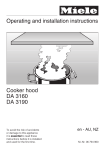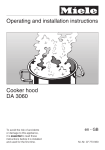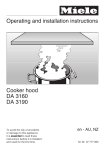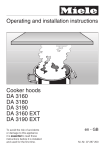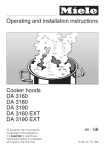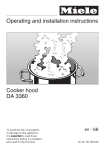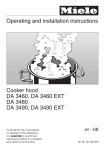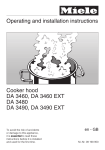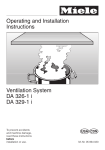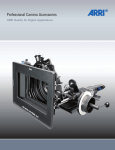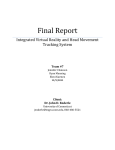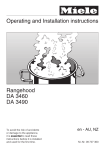Download Miele DA 292 i Operating instructions
Transcript
Operating instructions Cooker hoods DA 262 i DA 272 i DA 292 i In order to protect yourself and avoid damage to your machine, it is absolutely necessary to read the operating instructions prior to installation and operation. ]ö M.-Nr. 04 076 101 Description of the appliance Description of the appliance 1 2 3 DA 262 i 4 5 6 8 7 DA 272 i / DA 292 i 4 2 5 6 7 8 Description of the appliance Description of the appliance The cooker hood is suitable for . . . d - Slide switch for ,,Power selection“ . . . Air extraction: Air is drawn in through the grease filter f, cleaned and directed outside. . . . Air recirculation: Air is drawn in through the grease filter f and then through the active charcoal filters for cleaning. It is passed back into the kitchen through the top of the kitchen cabinet. Before using for the first time, check to see whether the active charcoal filter is in place (see ”Cleaning and Care“). b - Slide switch for cooktop illumination n This is used to switch the cooktop illumination g on and off, regardless of whether the cooker hood is in operation or not. The deflector plate must be pulled out about one inch for the light to work. 0 - Light off l - Light on c - Slide switch for the fan m This is used to switch the fan on and off. 0 - Fan off l - Fan on The power of the cooker hood can be adjusted to the intensity of the kitchen vapors and has four settings. The fourth setting (Intensive setting) should be selected for removing very strong kitchen vapors. low power.......strong power e - Deflector plate The deflector plate can be pulled out to any extent up to its limit. The action of pulling the deflector plate out and pushing it in switches the cooker hood on and off respectively. The slide switch for the fan must be set to setting ,, l “. h - Grease filter retainer This is used for securing or releasing the grease filter f from the cooker hood. i The control panel can either - be fitted with an aluminium front facia panel, available from Miele, - be fitted with a lightshield from the kitchen furniture programme, or - be installed without either of the above, but with cover caps (supplied for fitting at each end). 3 Contents Contents Description of the appliance . . . . . . . . . . . . . . . . . . . . . . . . . . . . . . . . . . . . . . . . . 2 Help to protect our environment. . . . . . . . . . . . . . . . . . . . . . . . . . . . . . . . . . . . . . 5 Warning and Safety instructions . . . . . . . . . . . . . . . . . . . . . . . . . . . . . . . . . . . . . 6 Operation . . . . . . . . . . . . . . . . . . . . . . . . . . . . . . . . . . . . . . . . . . . . . . . . . . . . . . . . 9 Cleaning and care . . . . . . . . . . . . . . . . . . . . . . . . . . . . . . . . . . . . . . . . . . . . . . . . 10 After Sales Service. . . . . . . . . . . . . . . . . . . . . . . . . . . . . . . . . . . . . . . . . . . . . . . . 12 Electrical connection . . . . . . . . . . . . . . . . . . . . . . . . . . . . . . . . . . . . . . . . . . . . . . 13 Technical data. . . . . . . . . . . . . . . . . . . . . . . . . . . . . . . . . . . . . . . . . . . . . . . . . . . . 14 Installation Appliance dimensions . . . . . . . . . . . . . . . . . . . . . . . . . . . . . . . . . . . . . . . . . . . . . . Wall unit dimensions . . . . . . . . . . . . . . . . . . . . . . . . . . . . . . . . . . . . . . . . . . . . . . . Building in . . . . . . . . . . . . . . . . . . . . . . . . . . . . . . . . . . . . . . . . . . . . . . . . . . . . . . . Depth alignment. . . . . . . . . . . . . . . . . . . . . . . . . . . . . . . . . . . . . . . . . . . . . . . . . . . Fitting the light tube cover . . . . . . . . . . . . . . . . . . . . . . . . . . . . . . . . . . . . . . . . . . . Removing the transit strips. . . . . . . . . . . . . . . . . . . . . . . . . . . . . . . . . . . . . . . . . . . Fitting the cover caps. . . . . . . . . . . . . . . . . . . . . . . . . . . . . . . . . . . . . . . . . . . . . . . Preparing the lightshield . . . . . . . . . . . . . . . . . . . . . . . . . . . . . . . . . . . . . . . . . . . . Fitting the front facia panel / lightshield . . . . . . . . . . . . . . . . . . . . . . . . . . . . . . . . . Dismantling . . . . . . . . . . . . . . . . . . . . . . . . . . . . . . . . . . . . . . . . . . . . . . . . . . . . . . 16 16 17 18 19 19 19 19 21 21 Air extraction . . . . . . . . . . . . . . . . . . . . . . . . . . . . . . . . . . . . . . . . . . . . . . . . . . . . 22 Air recirculation . . . . . . . . . . . . . . . . . . . . . . . . . . . . . . . . . . . . . . . . . . . . . . . . . . 24 4 Help to protect our environment Help to protect our environment Disposal of packaging The transport and protective packing is mostly manufactured from the following re-usable materials: . . . Corrugated paper / cardboard mostly from recycled materials. . . . CFC-free molded polystyrene. . . . Polyethylene foil (PE) partly from secondary raw materials. Disposal of your old machine Old machines contain materials which can be recycled. Please contact your local authorities or scrap merchant about potential recycling schemes, before disposing of the appliance. Read the notes on page 6 before disposing of the appliance. Rather than just throwing these materials away, please take them to the nearest local authority collection point for specific waste. 5 Warning and Safety instructions Warning and Safety instructions Read these Operating Instructions carefully before installing or using the Exhaust Hood. This appliance is intended for residential use only. Use the appliance only for its’ intended purpose. The manufacturer cannot be held responsible for damages caused by improper use of the hood. Read all the instructions before installing or using for the first time. SAVE THESE INSTRUCTIONS AND REVIEW THEM PERIODICALLY This appliance is to be used for ventilating cooking smoke / odors only. Do not use it to vent hazardous or flammable furnes or materials. Be certain your appliance is properly installed and grounded by a qualified technician. To guarantee the electrical safety of this appliance, continuity must exist between the appliance and an effective grounding system. It is imperative that this basic safety requirement be met. If there is any doubt, have the electrical system of the house checked by a qualified electrician. The manufacturer cannot be held responsible for damages caused by the lack, or inadequacy of, an effective grounding system. Do not allow children to play with the hood or its controls. 6 Repairs on electrical appliances should only be performed by qualified personnel. Do not repair or replace any part of the appliance unless specifically recommended in this manual. Before servicing, disconnect the power supply by either removing the fuse or manually “tripping” the circuit breaker. Do not turn on the hood until it has been proberly installed. Do not connect the appliance to the main electrical supply using an extension cord. Extension cords do not meet the safety requirements of this appliance. Do not cook on an open flame beneath the exhaust hood. Flames could be drawn up into the hood by the suction or the grease filters may ignite. Do not leave the cooktop unattended while in use. Overheated food can ignite. When installing the hood, make sure that the minimum safety distances between the cooktop and hood are maintained. – For electric cooktops: 18" (45 cm) – For gas cooktops: 26" (65 cm) Only metal ductwork should be connected to the exhaust hood. Any fittings, sealant, or materials used to install the ductwork must be made of non-flammable materials. Warning and Safety instructions Never connect an exhaust hood to an active chimney, dryer vent, vent flue, or room ventilating ductwork. Seek professional advice before connecting an exhaust hood vent to an existing, inactive chimney or vent flue. Do not place this exhaust hood over cooktops burning solid fuel. Never operate gas burners without pots. Heat generated by prolonged operation of gas burners without pots could damage the hood. Do not use the exhaust hood without the grease filters in place. Clean the grease filters regularly. Saturated filters are a fire hazard. Do not use a steam cleaner to clean the hood. The steam could penetrate to electrical components and cause a short circuit. To reduce the risk of cooking fires: – Keep the fan, filters and cooking area clean and free of grease. – Turn on the hood when cooking at high temperatures. – Heat oils slowly. Only use the high settings of the range or cooktop when necessary. – Never leave a turned on range or cooktop unattended. – Always use cookware and utensils that are appropriate for the type and amount of food being prepared. When connecting the hood to an external vent, make sure that there is adequate ventilation in the room where the exhaust hood is to be used. When using the hood in the same area as other appliances requiring room air (e.g. non-electric water heaters, gas cooktops, gas ovens, etc.) make certain that the air extracted by the hood does not hinder their operation. These appliances need air for combustion. Adequate ventilation can be maintained by installing air vents in windows or walls or by ensuring that the hood can only be turned on when the other appliances are off, or vice versa. To prevent combustion gases being drawn back into the room by the exhaust hood, the underpressure in the room must be no greater than 6 psi (0,04 mbar) when the hood and these appliances are running simultaneously. If there are any doubts as to whether there is adequate ventilation, consult an experienced professional. The above ventilation restrictions and warnings do not apply if the exhaust hood is retrofitted with an air recirculation kit. Do not use water on grease fires. Smother any fire or flame, or use a dry chemical or foam-type extinguisher. 7 Warning and Safety instructions Warning and safety instructions Disposal of discarded appliances Before discarding an old appliance, disconnect its power cord to prevent it from becoming a hazard. SAVE THESE INSTRUCTIONS AND REVIEW THEM PERIODICALLY Throughout the manual, important safety items will be highlighted in boxes and should be read in conjunction with these “Warning and Safety instructions”. 8 Operation Operation After cooking If, after finishing cooking, there are still cooking vapors in the kitchen, it is recommended that the cooker hood be left on for some minutes longer. Then switch the cooker hood off by: moving the slide switch for the fan and the cooktop illumination switch to the ”0“ position. Pull out the deflector plate. Drop down the front control panel or lightshield. or push the deflector plate in. Set the slide switch for the fan to position ”l“. The cooker hood will operate at the setting the power selector is set to. Select a power setting strong enough to clear the air: 1 2 3 IS Setting 1-2 = for normal operation Setting 3-Intensive setting (IS) = for removing heavy cooking odors Switch on the cooktop illumination switch if required. 9 Cleaning and care Cleaning and care Before any cleaning or maintenance work, the extractor must be disconnected from the mains supply (switch off at the wall socket and remove plug or the fuse). Cleaning The cooker hood housing may be cleaned using hot water to which a little mild detergent has been added. Dry with a soft cloth. Never use a cleaner which scours or contains chlorine, acids or soda. These would damage the surface of the cooker hood. To remove the grease filters push the filter holder retainers towards the middle. Take out the grease filters. DA 272 i, DA 292 i only: Grease filters Re-usable metal grease filters are builtin which remove solid particles (oil, dust, etc.) from the kitchen vapors, preventing soiling of the cooker hood. The grease filters can be cleaned in a dishwasher or by hand. The grease filters should be cleaned regularly to ensure a trouble free operation of the extractor fan, at least every 1 or 2 months, or when they are visibly saturated or no longer effective. An over-greasy filter can lead to danger or fire. Press the clips at the side in using a blunt instrument and remove the retainers. Pull the filter cassettes and link pieces out for cleaning. Clean the edges of the frame by hand. The other parts can be cleaned in the dishwasher. Clean the grease filters . . . . . . by hand: with a scrubbing brush in hot water with detergent. . . . in a dishwasher: place the filters with the short side upright in the lower basket, ensuring the spray arm is not obstructed. After cleaning, leave the filters to dry for a while on an absorbent surface before putting back in place. 10 Cleaning and care Cleaning and care When removing the filters for cleaning, also clean off any residues of oil or fat from the filter housing to prevent the risk of these catching fire. DA 272 i, DA 292 i only: Put the filters back together. When re-inserting the filters ensure that the locking device faces down towards the cooktop. If a filter is inadvertently replaced the wrong way a round, use a small screwdriver blade to unlock the filter through the slots. Changing the light tube and/or starter Release the light tube and the starter by turning them and then lifting them out of their holders. Replace the fluorescent tube or starter. Inserting or changing the active charcoal filters. If the cooker hood is connected for recirculation, active charcoal filters must be inserted, in addition to the grease filters. These filters absorb normal kitchen odors. Pull out the deflector plate and remove the rear grease filter. Disconnect the cooker hood from the mains supply (switch off at the wall socket and remove plug or the fuse). When removing or changing the active charcoal filters, push the filter holder retainers towards the middle. When inserting the active charcoal filters, ensure that the locking device faces down towards the cooktop. The active charcoal filters should be replaced when kitchen odors are not being absorbed, at least every 3-4 months. Unscrew the fixing screws at the left and right hand side. While doing so, hold the light cover securely and then take it out. 11 After Sales Service After Sales Service In the event of any fault which you cannot correct yourself please contact Your Miele Dealer or The Miele Service Department The address of the nearest Service Department is given on the back page. When contacting the Service Department, please quote the Model and Serial No. of the appliance, both of which are shown on the data plate. This is visible after removing the rear grease filter. 12 Electrical connection Electrical connection For CDN only: The cooker hoods are supplied with a 1.50 m power supply cable ready for connection to an a.c. single phase 120 V / 60 Hz supply. Caution: Ensure that power supply is OFF during installation. Important The wires in the power supply cable are colored in accordance with the following code: Green = ground Black = live White = neutral WARNING THIS APPLIANCE MUST BE GROUNDED For USA only: The cooker hoods are supplied with a 5 ft power supply cable ready for connection to an a.c., single phase, 120 V / 60 Hz supply. Connection should be made in the junction box. Important The wires in the power supply cord are colored in accordance with the following code: Green/yellow = ground Blue = neutral Brown = live As the colors of the wires in the power supply cord of this appliance may not correspond with the colored markings identifying the terminals in your junction box, proceed as follows: The wire which is colored green and yellow must be connected to the terminal junction box which is marked by the letter E, or by the earth symbol z or colored green or green and yellow. The wire which is colored blue must be connected to the terminal which is marked with the letter N or colored white. The wire which is marked brown must be connected to the terminal which is marked with the letter L or colored black. WARNING THIS APPLIANCE MUST BE GROUNDED 13 Technical data Technical data Total rated load Light Voltage Frequency Fuse rating Connection cable with plug Maximum air throughput: Air extraction Air recirculation 14 DA 262 i DA 272 i DA 292 i 225 W 15 W 120 V 60 Hz 15 A 5 ft (1,5 m) 223 W 13 W 120 V 60 Hz 15 A 5 ft (1,5 m) 235 W 16 W 120 V 60 Hz 15 A 5 ft (1,5 m) 90-325 CFM (150-550 m3/h) 90-325 CFM ( 150-550 m3/h) 90-325 CFM (150-550 m3/h) 50-240 CFM (80-350 m3/h) 50-240 CFM (80-350 m3/h) 50-240 CFM (80-350 m3/h) Installation Installation For installing the cooker hood, a cabinet is required. The minimum cabinet width required for each model is given below: – DA 262 i = 600 mm (23 5/8") – DA 272 i = 700 mm (21 9/16") – DA 292 i = 900 mm (35 7/16") The exhaust connection must be made by a suitably qualified and competent person. The distance between the top of the cooktop and the bottom of the cooker hood should be at least: 45 cm (18") above electric cooktops 65cm (26") above gas cooktops. Safety regulations prohibit the fitting of a cooker hood over solid fuel stoves. 15 Installation Installation Appliance dimensions Wall unit dimensions A: DA 262 i = 560; DA 272 i = 660; DA 292 i =860 B: DA 262 i = 595; DA 272 i = 695; DA 292 i =895 5 15 ˝ /16˝ 415 /16 6 5/8˝ 2˝ 13/16˝ 1313/16˝ 25/16 ˝ 10 7 /16˝ A: DA 262 i = 22 1/16’’; DA 272 i = 26’’; DA 292 i =33 7/8’’ B: DA 262 i = 23 5/8’’; DA 272 i =27 9/16’’; DA 292 i=35 7/16’’ A: DA 262 i = 562-568 = 22 1/8" - 22 3/8" DA 272 i = 662-668 = 26 1/16" - 26 5/16" DA 292 i = 862-868 = 33 15/16" - 34 3/16" B: DA 262 i = 600 = 23 5/8" DA 272 i = 700 = 27 5/8" DA 292 i = 900 = 35 1/2" 170-235 = 6 3/4" - 9 1/4" 135 = 5 3/8" 430 = 17" 110 = 4 11/16" 20 = 3/4" 285-350 = 11 1/4" - 13 7/8" The dividing wall must be removable to enable the cooker hood to be adjusted for height and depth. 515/16˝ 107/16˝ max. 1615/16˝ * plus depth of control panel 16 Installation Installation Building in Take the dividing wall out of the wall unit. Push the brackets into the slots on the sides of the cooker hood. 19 mm ( 3/4 ") thick side walls: Secure the support tracks to both interior walls of the unit using two 3,5 x 16 mm ( 5/8 ") screws, position as illustrated. 16 mm ( 5/8 ") thick side walls: Fasten the brackets in place on the cooker hood using the M 6 x 10 mm hexagonal bolts and washers. The thickness of the side walls must be taken into account. 17 Installation Installation Lift the cooker hood into the unit from below until the lugs of the brackets lie above the support tracks. Then carefully lower the cooker hood. The lugs engage with the support track. Feed the air extraction or air re-circulation connector through as applicable, (see chapter ”Air extraction“ / ”Air re-circulation“). Replace the dividing wall in the wall unit. Pull the deflector plate out to its limit and remove the grease filters. 4 holes (DA 262 i / DA 272 i) or 6 holes (DA 292 i) are now visible. Use a sharp pointed instrument through these holes to gouge out the fixing holes. Then screw the cooker hood securely to underside of wall unit. Replace the grease filters. Depth alignment To align the height, turn the M 6 x 19 mm adjuster screws clockwise or anti-clockwise. Move the cooker hood into its correct position. Units deeper than 285 mm require the fitting of a spacer bar to prevent vapours collecting between the rear of the cooker hood and the wall. 2 1 1 Secure the cooker hood on both sides using four 3 x 16 mm ( 5/8 ")screws for each side. 18 To achieve the correct depth shorten the . . . . . . spacer bar at the required breaking points. . . . End caps. Fit the end caps (1) to both ends of the spacer bar. Installation Installation Attach the spacer bar to the guide rail (2) located behind the light tube. Fitting the light tube cover – DA 262 i Pull off the transit strips on each side. Fitting the cover caps For cooker hoods without a front panel or lightshield: Position the light tube cover and screw into place (see diagram). – DA 272 i, DA 292 i Attach the extension pieces supplied to the light tube cover, then position the now extended light tube cover and screw into place. Removing the transit strips Pull the deflector plate out to its limit. Push the Allen screws from the accessory kit onto the cover caps until the screw heads lie directly under the holes in the cover caps. Secure the cover caps on both sides of the deflector plate using the Allen screws. Preparing the lightshield Lightshields . . . . . . weighing up to 600 g can be fitted normally. . . . Those weighing over 600 g need to have the springs in the snap fittings pretensioned: 19 Installation Installation Only use the template for lightshields with the following lengths: b c d e f Pull out the snap fittings from the slots on the left and right hand sides of the deflector plate (1). Press the baffle (2) into the engaging point. Put the snap fittings back in place. The snap fitting with the hole must be inserted on the right. Do not wipe off any lubricant. Hold the template supplied against the back of the lightshield and mark the drill hole positions for fixing the hinges. 20 b c d e f DA 262 i DA 272 i Da 292 i 598 mm 698 mm 898 mm 597 mm 697 mm 897 mm 596 mm 696 mm 896 mm 595 mm 695 mm 895 mm 599 mm 699 mm 899 mm DA 262 i 23 9/16" DA 272 i 27 1/2" Da 292 i 35 3/8" 23 1/2" 27 7/16" 35 5/16" 23 1/2" 23 7/16" 27 7/16" 27 3/8" 35 5/16" 35 1/4" 23 9/16" 27 1/2" 35 3/8" With other lengths adjust the measurements accordingly. Installation Fitting the front facia panel / lightshield Dismantling Disconnect the appliance from the electricity supply by unplugging at the socket, or removing the mains fuse. Take the dividing wall out of the wall unit. Release the hose clip from the exhaust connection and push the hose upwards. Screw the hinges (2) supplied to the left and right hand sides of the front facia panel / lightshield (1). With the Miele aluminium lightshield the screws are supplied. For lightshields with a Miele kitchen furniture programme use 3.5 x 16 mm ( 5/8 " ) screws supplied. Push the Allen screws from the accessory kit onto the cover caps until the screw heads lie directly under the holes in the cover caps. Loosen the securing screws used to screw the cooker hood to the side walls. Pull the deflector plate out to its limit and remove the grease filters. Remove the screws now visible (DA 262 i / DA 272 i = 4; DA 292 i = 6) using a Philips screwdriver. Raise the cooker hood and then lower it to remove. Hold the front facia panel / lightshield against the deflector plate: the holes in the hinges must lie over the holes visible in the deflector plate (3). Secure the cover caps an fascia panel / lightshield on both sides of the deflector plate using the Allen screws. 21 Air extraction Air extraction Danger of toxic fumes. Please heed the ,,Warning and Safety Instructions“ to avoid the dangers of toxic fumes. The cooker hood should be installed according to local building regulations. Seek approval from the building inspector where necessary. Connection for extraction – The extraction ducting should be as short and straight as possible. – To ensure efficient air extraction the diameter of the exhaust ducting should not be less than 125 mm (5"). The use of flat ducting also reduces the air extraction efficiency. – The use of exhaust ducting with a diameter less than 125 mm (5") and flat ducting increases the noise level of the cooker hood. – Only use wide radius bends. Tight bends reduce the air throughput of the cooker hood. – Only use smooth or flexible pipes made from non-flammable materials for exhaust connection. – Where ducting is horizontal, it must be laid to slope away at 1 cm per metre (1/8" per foot) , to ensure no condensation drains into the appliance. – If the exhaust air is to be ducted outside, the installation of a Miele telescopic wall vent is recommended. 22 – If the exhaust air is to be ducted into a vent flue, the ducting must be directed in the flow direction of the flue. Connection Only use narrower diameter pipework where it is unavoidable, for example where existing pipework has to be used. The narrower the diameter the lower the performance and the noisier the operation. If a connection to 100 mm (4") diameter piping is to be made, fit the reducer supplied (adaptor) on to the exhaust connection of the cooker hood. Air extraction Air extraction Measure the total length of the exhaust ducting to be used. Add the appropriate length of additional piping to this figure (see table), according to the number and type of bends: Type of bend Push the ducting on to the cooker hood exhaust connector or on to the reducer (adaptor) and secure. Note If the exhaust ducting is to run through rooms, ceiling space etc. where there may be great variations in temperature between the different areas, the problem of sweating or condensation will need to be addressed. The exhaust ducting will need to be suitably insulated. In addition to insulating the exhaust ducting it may also be necessary in some cases to install a suitable condensate trap to collect and evaporate any condensate which may occur. When installing a condensate trap, ensure that it is located vertically and if possible directly above the exhaust connection. Angle of bend Radius of bend Length of additional piping in inch in mm in foot Wall vent duct with grill and flap in metres 3,3’ 1.0 1 3/4 3/4 1/2 0.3 0.2 0.2 0.1 Smooth interior wall bends 90° 90° 45° 45° Elbow bend 90° 45° 6 3/4 1 3/4 2.0 0.5 Bend in rent hose Flexible piping 90° 2 1/2 0.7 1 1 3/4 3/4 3/4 1/2 0.35 0.3 0.2 0.2 0.15 0.1 90° 90° 90° 45° 45° 45° 5 10 5 10 5 10 20 5 10 20 125 250 125 250 125 250 500 125 250 500 Calculation of extraction ducting A pipe diameter of 125 mm (5’’) should ensure trouble-free extraction up to a total pipe length of 33 m (108’’). Determine the total pipe length as follows: 23 Air recirculation Air recirculation If site conditions are not suitable for the cooker hood to be used for air extraction, the appliance must be converted for recirculation. Connection The following parts are necessary for this, available from your Miele Dealer or from the Miele Spare Parts Department: Conversion kit from extraction to recirculation (Ø 125 mm, 5") Active charcoal filter Place the hose with the directional grill on to the exhaust connection of the cooker hood. Secure the hose on the exhaust connection using a hose clip. Ensure that the air outlet from the directional grill is pointed towards the kitchen interior. It should on no account point towards a wall. Screw the directional grill to the wall unit. If there is a soffit, an appropriate cut-out in the soffit must be made. Insert the active charcoal filter in the cooker hood (see chapter ”Cleaning and Care“). 24 25 27 Alteration rights reserved / 44 / 001 CDN, USA - 1998 This paper is made from 100% chlorine-free bleached cellulose and therefore protects the environment.




























